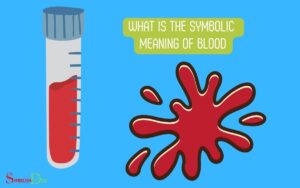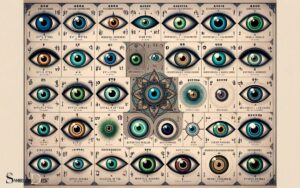What Is the Symbolic Meaning of a Peacock? Nobility!
The peacock is a symbol of nobility, immortality, and renewal across various cultures. Its vibrant tail feathers, which fan out in a display of stunning colors and patterns, are associated with beauty, pride, and the all-seeing eye due to the eye-like designs on the feathers.
Explanation The symbolic meaning of a peacock varies but generally includes:
- Nobility and Royalty: Its dignified presence has made it a symbol of royalty and nobility in many cultures.
- Immortality and Renewal: In ancient mythology, the peacock’s ability to shed its feathers and grow them back represents immortality and renewal.
- Beauty and Pride: The peacock’s striking appearance has made it synonymous with beauty, and sometimes, with the negative connotations of vanity and pride.
- Spiritual Awakening: In some cultures, the peacock symbolizes openness to spiritual awakening due to its expansive feather display.
- All-Seeing Eye: The eye patterns on the feathers are believed to symbolize omniscience and the watchfulness of the heavens.
| Culture | Symbolism |
|---|---|
| Greek | Immortality (associated with Hera) |
| Hindu | Benevolence, patience (associated with Saraswati) |
| Christianity | Eternal life, the incorruptible soul |
| Buddhism | Purity, compassion |
The peacock’s symbolism extends from its physical allure to profound spiritual metaphors, reflecting beauty and eternal wisdom.
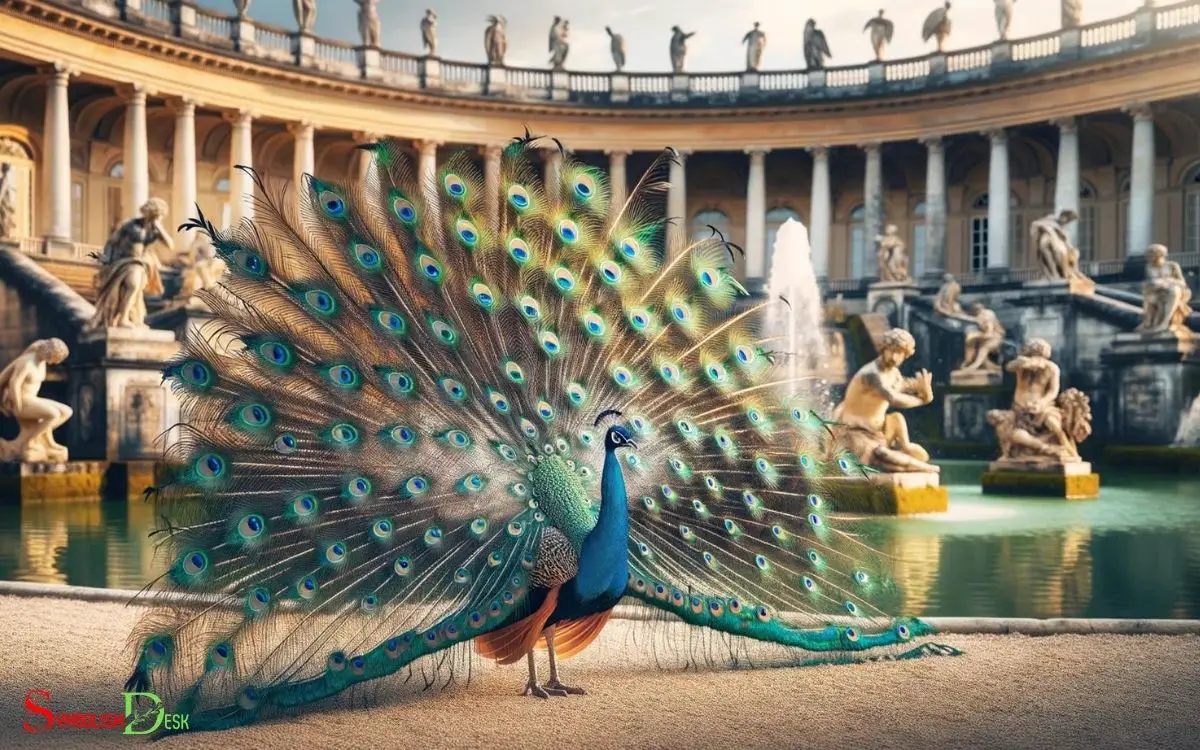
Key Takeaway
Historical Significance of Peacocks
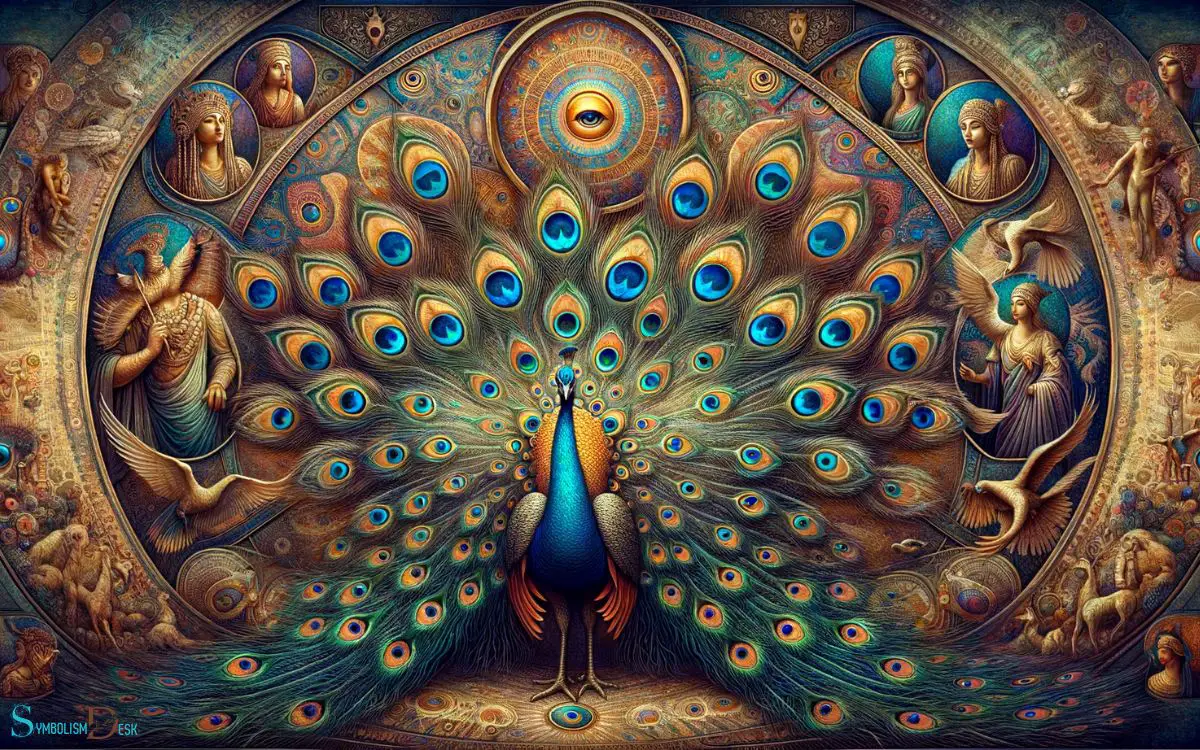
The historical significance of peacocks can be traced back to ancient civilizations where they were revered for their beauty and symbolism.
In many cultures, including those of Persia, India, and Greece, peacocks were associated with immortality, royalty, and spirituality. Their stunning plumage and regal bearing made them a symbol of luxury and opulence.
In Greek mythology, the peacock was linked to the goddess Hera, representing her watchfulness and protection.
In Christianity, the peacock’s shedding and regrowth of feathers were seen as symbols of renewal and resurrection. The bird’s association with the divine and the eternal made it a popular motif in art, architecture, and literature.
Through the ages, peacocks have maintained their status as emblematic creatures, continuing to captivate and inspire with their timeless allure.
Peacock Symbolism in Mythology
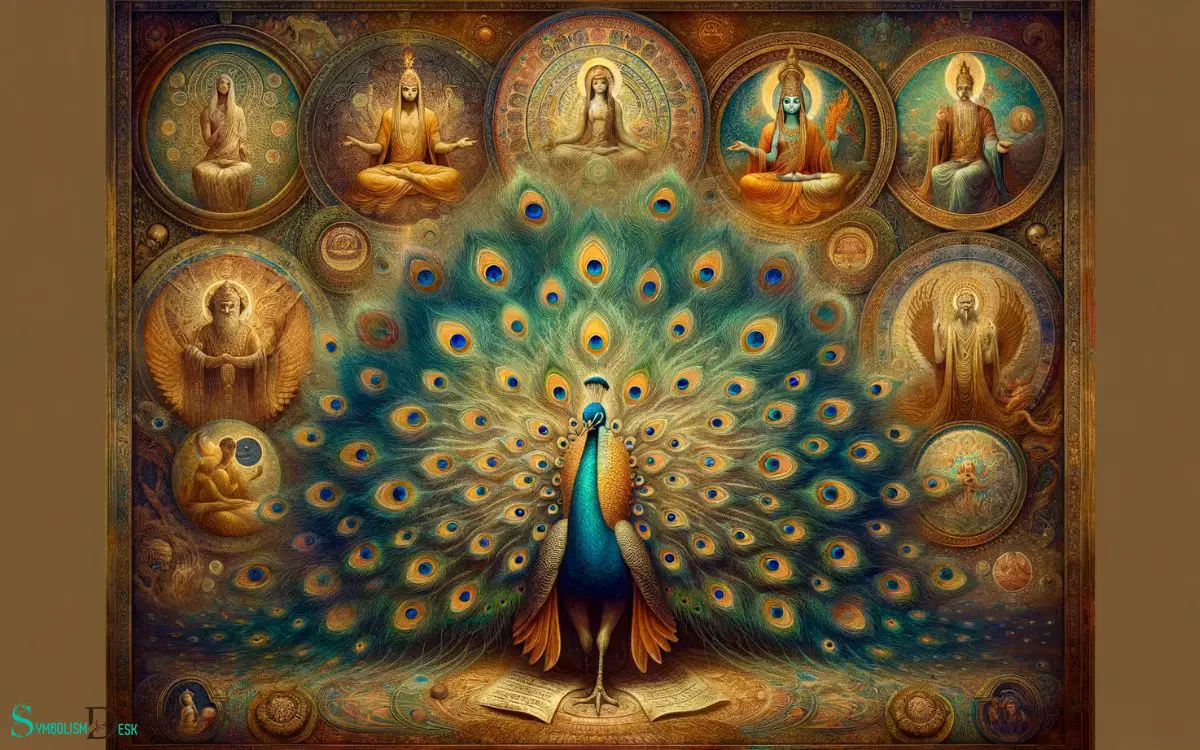
Associated with immortality, royalty, and spirituality in various ancient cultures, the peacock holds significant symbolism in mythology.
In Greek mythology, the tail of the peacock is linked to the ‘eyes’ on the tail feathers, which were said to have been bestowed by the goddess Hera. These ‘eyes’ symbolized the all-seeing eyes of the stars and were associated with her watchfulness.
In Hindu mythology, the peacock is associated with the goddess Saraswati, who’s the deity of knowledge, music, and art.
The peacock’s ability to eat poisonous plants without being affected by them led to its association with immortality and its depiction in various myths as a symbol of incorruptibility.
In many ancient cultures, the peacock’s regal appearance and distinctive demeanor made it a symbol of royalty and power.
Cultural Representations of Peacocks
Peacocks have been featured prominently in the cultural representations of various societies throughout history.
In many Eastern cultures, the peacock is a symbol of royalty, immortality, and beauty. In Hinduism, the peacock is associated with the goddess Saraswati, representing beauty and knowledge.
In China, the peacock is a symbol of dignity and beauty, often depicted in traditional art and literature. In Western cultures, the peacock has been a symbol of pride, luxury, and immortality, often depicted in medieval and Renaissance art.
The peacock’s vibrant plumage has also been a source of inspiration for fashion and design across various cultures. These cultural representations showcase the peacock’s enduring significance and its ability to captivate the human imagination.
This significance extends to the peacock’s role in different religions, where its symbolism takes on deeper spiritual meanings.
Peacock Symbolism in Different Religions
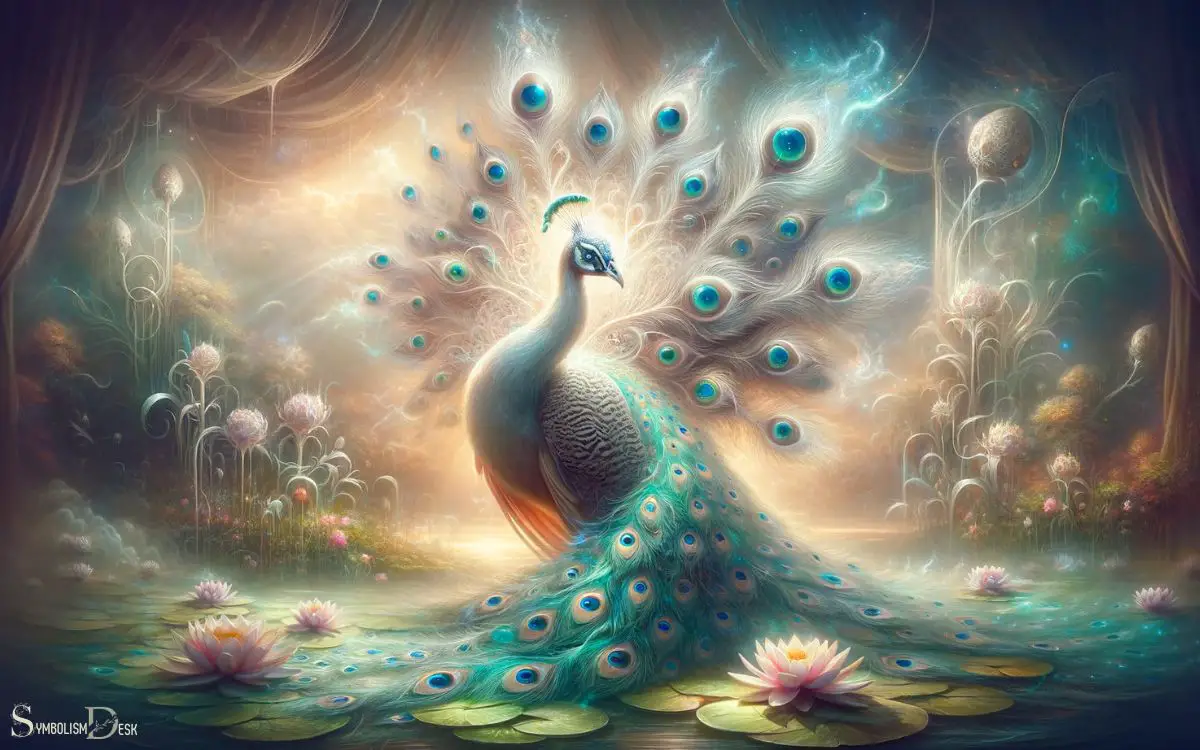
Peacocks hold symbolic significance in various religions.
In Hinduism, the peacock is associated with the goddess Saraswati and represents beauty and knowledge.
In Christianity, the peacock has been linked to resurrection and immortality.
In Islam, the peacock symbolizes eternal life and is believed to be the only creature that hasn’t consumed the forbidden fruit.
Peacock Symbolism in Hinduism
In Hinduism, the peacock symbolizes immortality, integrity, and protection. The peacock’s association with immortality comes from the belief that its flesh does not decay after death.
In Hindu mythology, the peacock is often depicted as the mount of the deity Kartikeya, symbolizing protection and divine guidance.
The vibrant colors of the peacock’s plumage are also believed to represent the celestial realm and the eyes on its feathers are seen as a symbol of wisdom and the all-seeing knowledge of the divine.
| Symbol | Meaning |
|---|---|
| Colors | Celestial realm |
| Eyes | Wisdom and divine vision |
| Mount | Protection and guidance |
Understanding the symbolic significance of the peacock in Hinduism provides insight into the rich tapestry of meanings attributed to this majestic bird.
Peacock Significance in Christianity
Christianity also attributes symbolic significance to the peacock, often representing resurrection and immortality, building on the themes of immortality and protection associated with the peacock in Hinduism.
The peacock’s association with immortality in Christianity is derived from the ancient belief that its flesh doesn’t decay. In Christian iconography, the peacock is often depicted with an aura of radiant colors, symbolizing the glory of the resurrection.
Additionally, the peacock’s ability to consume poisonous plants without being harmed is seen as a representation of the victory of Christ over death.
The peacock’s regal appearance and the belief in its incorruptibility have made it a symbol of Christ’s resurrection and the eternal life promised to believers.
This symbolism underscores the Christian belief in the triumph of life over death.
Peacock Symbolism in Islam
The peacock holds symbolic significance in Islam, representing various themes and concepts within the religion.
In Islamic tradition, the peacock is often associated with the concept of immortality, as its feathers were believed to be incorruptible. The bird’s vibrant and captivating appearance is seen as a reflection of the beauty of the divine creation.
Furthermore, in Sufi poetry and mysticism, the peacock is used as a symbol of the spiritual journey and the unveiling of the divine mysteries.
The bird’s ability to eat poisonous plants without being harmed is also seen as a metaphor for the believer’s ability to transcend the worldly temptations and remain uncorrupted.
The Peacock as a Symbol of Beauty
Peacocks symbolize beauty through their vibrant plumage and graceful displays. Their iridescent feathers and elegant courtship dances have captivated humans for centuries, making them a timeless symbol of aesthetic allure.
The striking appearance of peacocks has inspired artists, poets, and designers, who often incorporate the bird’s imagery into their work to evoke feelings of grandeur and elegance.
To further appreciate the peacock’s association with beauty, let’s explore some characteristics that contribute to its symbolic significance: One of the most striking features of the peacock is its vibrant and iridescent plumage, which has long been associated with beauty and grace. The peacock’s feathers are said to represent not only the colorful spectrum of emotions, but also the idea of renewal and resurrection. Additionally, the peacock’s association with purity symbolism interpretation comes from its depiction in various religious and mythological texts, where it is often seen as a symbol of purity and holiness.
| Symbolic Feature | Meaning |
|---|---|
| Vibrant Plumage | Opulence and grandeur |
| Graceful Displays | Elegance and allure |
| Symbol in Art | Aesthetic inspiration |
Peacocks embody the essence of beauty, serving as a reminder of the enchanting and mesmerizing aspects of the natural world.
As we delve into modern interpretations of peacock symbolism, it becomes evident that the bird’s significance continues to evolve and inspire.
Are Peacocks Considered a Symbol of Luck in Any Culture?
In Hindu culture, peacocks are seen as a symbol of luck and protection. Their vibrant feathers are believed to ward off negativity and bring good fortune. In some cultures, the peacock’s display of feathers represents immortality and the eternal cycle of life, echoing the symbolic meaning of shamrock.
Modern Interpretations of Peacock Symbolism
Modern interpretations of peacock symbolism have evolved to reflect its significance in contemporary culture. From being a symbol of beauty and opulence to representing spirituality and enlightenment, the peacock holds a diverse range of meanings today.
Its presence in art, fashion, and literature continues to shape its cultural significance, making it a dynamic symbol in the modern world.
Contemporary Peacock Symbolism
In contemporary society, people commonly interpret the peacock as a symbol of beauty, prosperity, and spiritual awakening.
The peacock’s vibrant plumage is often seen as a representation of beauty and grace, inspiring admiration and awe.
Additionally, the peacock’s association with wealth and prosperity stems from its perceived opulence and abundance.
In many cultures, the peacock is also linked to spiritual awakening and enlightenment due to its majestic appearance and the belief that it can guide individuals towards a higher consciousness.
Furthermore, the peacock’s ability to shed and regrow its feathers has been likened to the concept of renewal and transformation.
As a result, the peacock continues to be embraced as a symbol of positivity and personal growth in contemporary interpretations of its symbolism.
Cultural Significance Today
Contemporary society continues to ascribe new cultural significance to the peacock’s symbolism, reflecting evolving interpretations of its representation.
In modern times, the peacock has come to symbolize beauty, grace, and extravagance. It’s often associated with luxury, opulence, and vitality, making it a popular motif in fashion, art, and interior design.
The peacock’s vibrant and iridescent feathers have also become a symbol of pride, confidence, and self-expression in the LGBTQ+ community.
Additionally, in some cultures, the peacock represents immortality, renewal, and spirituality. Its symbolism has expanded to encompass themes of resilience and the ability to rise above challenges, making it a meaningful emblem in mental health awareness and support.
The peacock’s symbolism continues to evolve, resonating with contemporary values and societal narratives.
Conclusion
The peacock holds great symbolic significance across various cultures and religions, representing beauty, immortality, and spirituality.
Interestingly, in a study conducted by the University of Cambridge, it was found that the peacock has been a symbol of immortality in art and literature for over 2,000 years.

